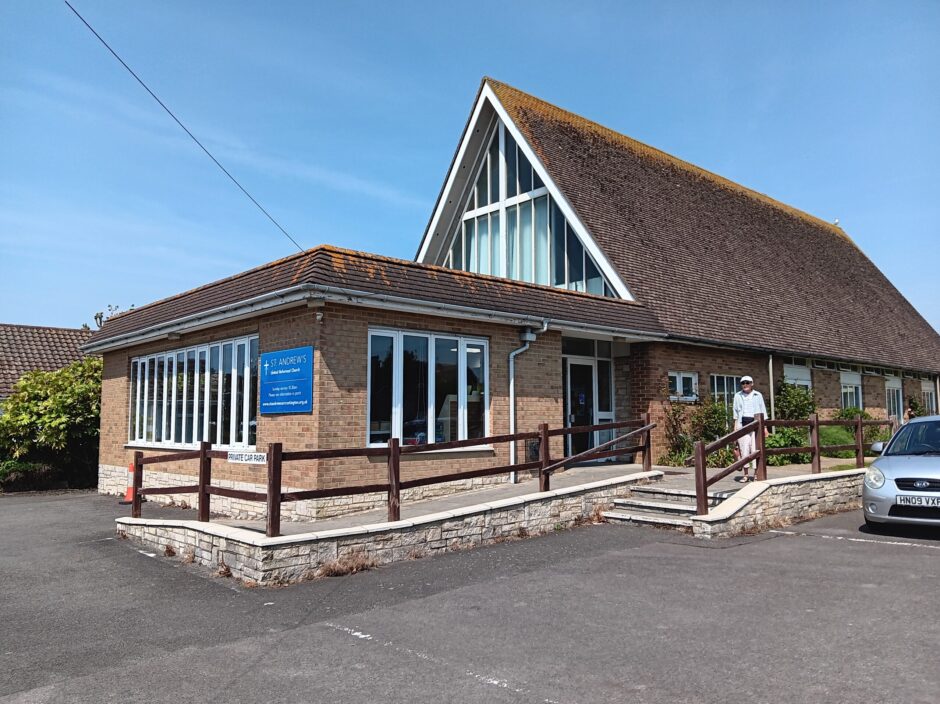Day three of the 2025 meeting of the United Reformed Church General Assembly at the Hayes Conference Centre in Swanwick opened with a Bible study led by Dr Francesca Nuzzolese, Professor of Pastoral Care at the Waldensian Theological School in Rome.
She invited members of Assembly to recreate holy silence they experienced yesterday: centre themselves, meet Jesus and reconnect with holy rest.
She explained that the care for oneself, which she described yesterday, is the first step of journey, not to be mistaken for destination. Our destination is care for our neighbour out of radical compassion. But not all of us manage this, including those in and training for pastoral ministry. Why?
Dr Nuzzolese suggested that the Old Testament directs us to compassion for the other quite narrowly defined: widows, orphans. Jesus, in contrast, stretches the definition to breaking point. Jesus calls us to move in compassion towards the other who threatens us.
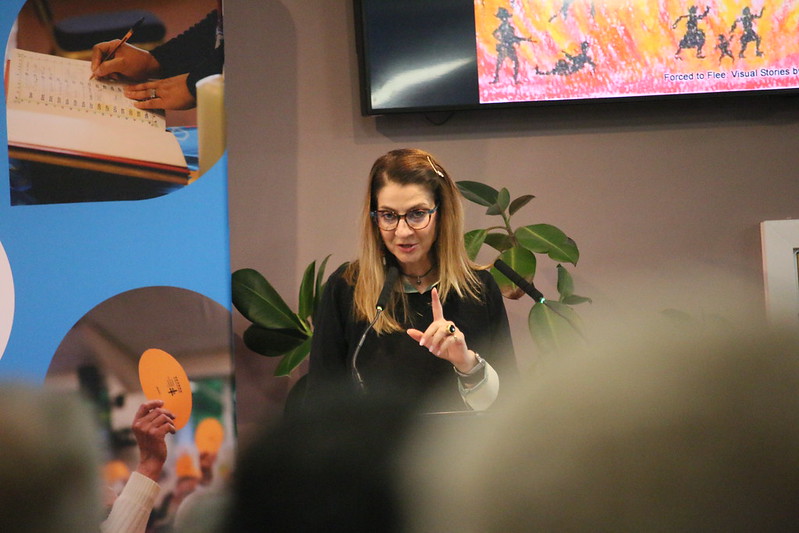
We are wired to protect and to run away, not to move kindly towards danger. A few are able: Martin Luther King, Nelson Mandela, Jesus.
And the Samaritan in Jesus’ story. What enables him to cross boundary and move toward suffering?
In Christ we are seen, loved and healed. But, said Dr Nuzzolese, we see the limits of this in most people’s behaviour. Belief and practice are in tension.
Biblical seeing is not a glance, it is giving attention to someone, becoming attuned to them, comprehending them. This is what a parent does to a baby, and it can stop the baby crying. Something similar happens in therapy: being attuned to someone gives us power to communicate compassion, which leads to healing. She quoted the Christian mystic Simone Weil: ‘Attention is the rarest and purest form of generosity.’
Jesus asks same of us, said Dr Nuzzolese. The Greek word that is translated ‘compassion’ in the story of the Good Samaritan describes a response at the level of the gut, the bowels. Empathy is not enough.
The movement towards suffering reflects the image of God in us. It is what God does in Christ. Jesus moved with compassion moves towards the enemy.
This movement, she said, requires inner resilience and spiritual maturity. It is not offered out of sense of duty but out of groundedness.
So why not normative, even for those being trained in pastoral care? Dr Nuzzolese suggested that some are not capable of it at a core human level. Woundedness can prevent us being attuned and stop us offering spiritual care without leaving the room sterile. Personal trauma can leave people too wounded to be healers. Anxiety and fear of attack can create unsafe spaces, maybe cause us to shut down. Spiritual fatigue, she said, can also leave a film over the eyes prevents the kind of seeing that leads to compassion.
For these reasons we need to cultivate spiritual practices, contemplation and safe relationships. So, Dr Nuzzolese again concluded by leading Assembly in receptive centred prayer.
Session seven
Paper N1 Church Life Review – Progress and local church perspective
At General Assembly 2025, the Revd Steve Faber, Convenor of the Church Life Review Steering Group, delivered a key presentation updating members on the progress of the Church Life Review (CLR), now in Phase Two (design).
Phase Two of the CLR, was tasked by General Assembly in 2023 to focus on four workstreams. These consist of financial resource sharing (finance), provision of shared support services (services), employment of lay workers (lay workers), and new URC communities of worship and discipleship (new communities).
The report does not present any final proposals or resolutions but sets the stage for the extraordinary session in November 2025, where decisions will be made.
The presentation showed the need for change within the wider challenges facing many Christian denominations across Europe, including declining membership, increased regulatory demands, and the lasting impact of the Covid-19 pandemic. It was acknowledged that many URC structures have remained largely unchanged since 1972, and that continuing “as is” is no longer viable.
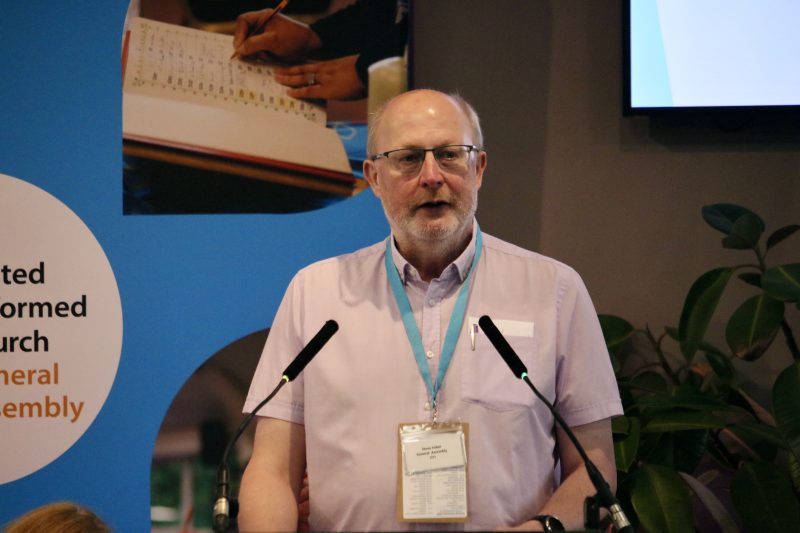
The work is guided by a collaborative process involving consultations and shaped by biblical inspiration, particularly Jeremiah 29’s encouragement to “get on with life.” The Steering Group has not heard from every member of the denomination but has heard from many across the Church in a way that has never happened before. Steve highlighted key gatherings that have taken place, with a variety of members of the URC serving in various roles, such as in June 2024 (finance), November 2024 (shared services) and January 2025 (new communities), and May 2025 (shared fund proposal) for examples.
Key proposals discussed include a central resources portal, shared administrative services (like payroll, HR, and IT), and the idea of employing lay workers more strategically, either at the local or Synod level. A major factor is the proposed Church Life Fund, which will finance these developments and provide support to churches and communities in need, whether urban congregations burdened by maintenance costs or rural areas struggling with isolation and decline.
The overall hope is of a flourishing URC that is less burdened and better enabled, with renewed energy for mission, evangelism, and discipleship.
Elizbeth Hall, a member of the CLR steering group gave a couple of examples of how the CLR can help local churches. She told a story of an urban church that had seen better days, was facing increased unfunded costs for maintenance. Which was burdened with thoughts around health and safety and safeguarding bureaucracy for groups renting its premises. The church has little energy left and its focus on mission and vision is crowded out by all the process and protocols. The CLR, Elizabeth explained, could help the church, not by providing the perfect solution, but by providing, for example, a central place for for agreed documents, where Health and Safety and risk assessment forms can be easily found. Advice can be provided around filling said form, along with the provision of “back room”. This can result in lifting enthusiasm and reduce anxiety.
Elizabeth gave another example featuring a rural church and their concerns around struggling to engage people in their communities to come to church, as a result of the reduction in local transport links, and people not living locally. The CLR could support for allowing space to focus on community and mission and support for eldership.
Another example given, was a place without a church, such as an estate identified as having a spiritual need by a group of people or a person with energy and mission on their minds. “What can CLR do?” asked Elizabeth, “it could make funding available for a new expression of the URC, or it might help improve something already there”.
Elizabeth explained clearly that the expectation was not that the CLR could fix everything found hard in churches, nor will it prevent discussions around church closures, but the hope for a church that is less burned, better enabled and flourishing is very important.
“It can support real cultural change in the URC and support renewal and growth,” she said.
The presentation concluded with an invitation to embrace changes with courage and hope, recognising that transformation, while challenging, is essential for the Church’s continued witness and growth.
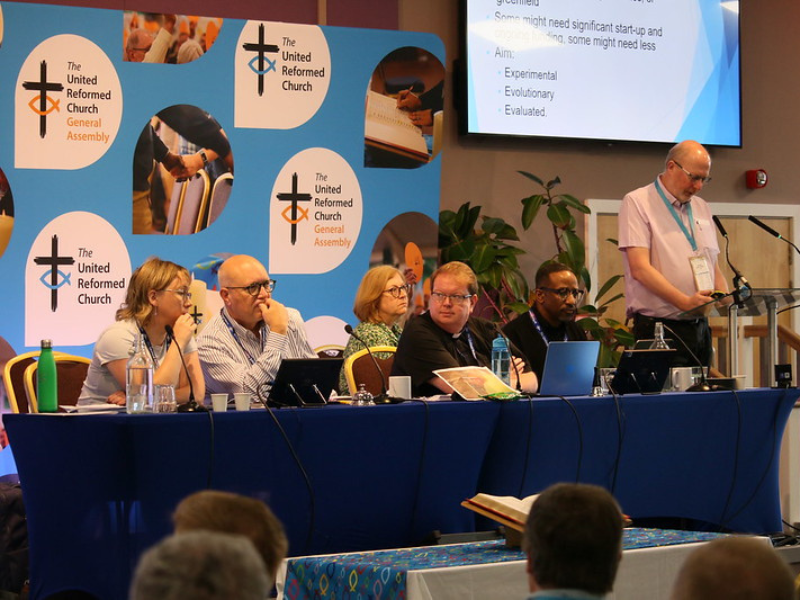
Session nine
Paper ADH2 Proposals for capacity and costs in formation of accredited and recognised ministries
Session ten
General Assembly Moderator’s address
“I am much more optimistic about the URC than when I began,” said the Revd Tim Meadows in his address as Moderator of General Assembly.
Tim said he had aimed to visit every synod during his year as Moderator and did so. He was enthusiastic about his visits to ministers’ retreats, CRCW retreats and Youth Assembly, and acknowledged the sacrifice made by his home churches.
He shared the unexpected power of being part of the Remembrance ceremony at the Cenotaph in November – and being glared at by Liz Truss.
“In the world today,” Tim said, “our witness to being a faith community which respects the worth and dignity of every human being is a bright light into the world.”
He reflected on the gift to the world of our antecedent churches through the heritage of our Congregationalist and Presbyterian governance – the gift of democratic government, not just for the people but by the people. That gift is under threat, he said, if churches revert to hierarchical ways of decision-making.
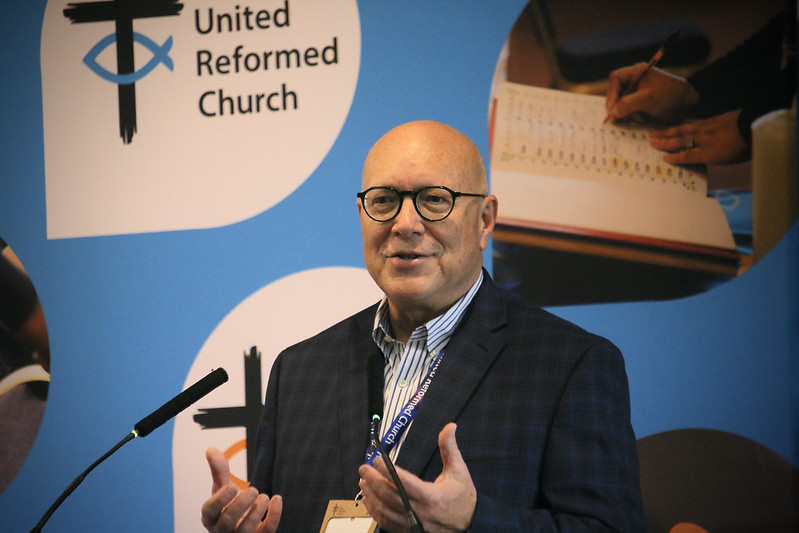
Tim said that in his travels during the year he found many churches had little relationship to General Assembly. “Does the General Assembly speak to or for the churches? Are we, who take part in General Assembly, going back and talking to our churches about General Assembly decisions?
He said it was vital for local churches to nail their colours to the mast. “In the beautiful diversity of our local churches and community, we need to reveal who we are. If your local church community is traditional, evangelical or liberal, say so in your website. If your church is welcoming and affirming of LGBT+ people, and has voted in marriage equality, identify yourself. This is critically important, because people outside the URC see the General Assembly’s public statements – and discover another story when they visit a local URC congregation.”
Tim ended by saying that in his dealing with other Churches in the UK and overseas, he found the URC is admired.
“URC, let’s nail our colours to the mast, get a little salty, and speak the truth. Most importantly, never lose sight that we are in this together and Jesus Christ is our centre. We have a beautiful little church, and the world needs to know we are here. Love never runs out. Rise to life, rise to action, rise to justice, rise to hope and rise to love!”
En bloc resolutions
The following resolutions were passed en bloc. En bloc resolutions are voted on without debate, having been deemed uncontroversial. This has no reflection on their importance. Read the full reports and resolutions in each case.
A1: Terms of Reference for the Faith in Action Committee
Terms of reference for the new committee and provision for urgent decision-making until it is established in the autumn
A2: Terms of Reference for the Ministries Committee
Terms of reference for the new committee and provision for urgent decision-making until it is established in the autumn
A3: Changes to the Committee Structure
The Equalities Committee becomes the Equality, Diversity, Inclusion and Belonging subcommittee of the Faith in Action Committee. The Faith and Order Advisory Group becomes the Faith and Order Reference Group, a subcommittee of the Business Committee.
A5: Terms of Reference and composition and name of the General Secretariat
The General Secretariat is now called the Senior Leadership Team, and has new terms of reference. It consists of the General Secretary, the Chief Operating Officer, the Deputy General Secretary (Faith in Action) and the Deputy General Secretary for Ministries (the new name for Secretary for Ministries). The Resources Committee will decide the make-up of the Team.
D1: Discipleship Development Fund
Increases to grants available from the fund, including a new category of awards for spontaneous discipleship development opportunities.
E1: Equalities report on ongoing work
An update from the committee
G2: Update from Resources Committee
A report on the first year of the committee’s work.
H1: Basis of Union Paragraphs 19-24: Ministry in the United Reformed Church
Changes to the Manual, defining the role of ministers in the URC.
H3: Ministries general report
An update on the work of the Accreditations Subcommittee and the Assessment Board.
H5: Sabbaticals
The frequency of sabbaticals increases from ten years to seven.
H6: Renaming of Models of Non-Stipendiary Ministry
New names for models of Non-Stipendiary ministry: Non-Stipendiary Minister;
Non-Stipendiary Minister (Local); Non-Stipendiary CRCW and Non-Stipendiary CRCW (Local).
J1: Report to General Assembly 2025
New nominations and changes to the Panel for General Assembly Appointments.
N1: Church Life Review progress update
A report on the work of the Review
T1: Safeguarding Committee annual report
An overview of safeguarding in the URC.
X1: Love’s Farm Church
Receiving Love’s Farm Church, in St Neott’s. Cambridgeshire, into the URC.
As per Paper A5 Terms of Reference and composition and name of the General Secretariat, the Revd Nicola Furley-Smith, Secretary for Ministries, was welcomed by members of the General Secretariat into her expanded role of Deputy General Secretary for Ministries. Andrea Heron, one of the General Assembly Moderator’s chaplains, led prayers and expressions of thanks for Nicola.
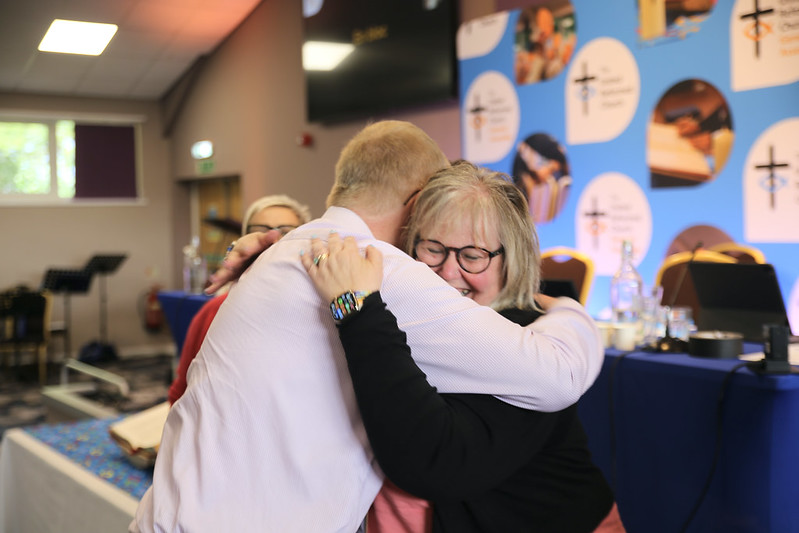
Love Farm Church, as outlined in X1 Love’s Farm Church – Eastern Synod, was welcomed as a new local URC congregation with a resounding round of applause.
Watch a short film about Love Farm Church:
[embedded content]
Jubilee and New Ministers
The notable anniversaries of the ordination of the following ministers were celebrated:
50 years
- Bryan Michael Alderson
- David Wilton Atkinson
- Stuart James Brock
- Martin Frederick Camroux
- Graham Carling
- Barry Edward Carter
- Gwynfor Berwyn Evans
- David Grosch-Miller
- Moira Helen Kerr
- Kenneth Orr Lynch
- Marian Horman McKean
- Robert Parker
- Jaroslav Raich
- Bryan Reginald Shirley
- Bob Wylie White
60 years
- Kenneth Graham
- Malcolm Gerald Hanson
- David Leslie Helyar
- Donald Horsfield
- Stuart Jackson
- Derek John Kingston
- Nanette Lewis-Head
- Geoffrey Edward Hodgess Roper
- Jacqueline Mary Smith
- Keith John Spence
- Brian Woodcock
- Brian A Wren
70 years
- James Ronald Garfitt
- Roger John Hall
- Raymond Arthur Moody
- John Brian Sturney
The General Assembly greeted Ministers present at the meeting who had been admitted to the Roll of Ministers since the last Assembly. The full list of those Ministers are:
- Joseph Amoah, Harrogate St Paul’s
- Siobhan Antoniou, Reigate Park; Banstead; Dorking; Redhill
- Stephanie Atkins, Greater Manchester South Missional Partnership
- Julia Bartholomew, Old Colwyn; Rhos-on-Sea
- Stanslous Chatikobo, Trinity Church, Ashwell & Walkern & Sandon United Church
- Simon Cross, Hull Area: Hull St Ninians & St Andrews, Cottingham Zion & Newland, Swanland Christ Church, Peters House
- Julie Jefferies, Prestbury URC
- Alecia Johnstone, North Western Synod, Chaplain at HMP/YOI Preston
- Maria Lee, Bolton & Salford Missional Partnership
- Kate Wolsey, Pembrokeshire Transitional Minister
Paper I2 A Missional Lens for the URC
Sarah Lane Cawte, Convenor of the Mission Committee, brought a strategic paper to Assembly but said she hoped it would be inspiring – and said the task is to focus on what happens next.
The paper drew together recent Assembly decisions to provide a missional focus for the URC over the next four years. The Mission Committee asks all committees to focus on four areas:
- Address issues of racial injustice
- Prioritise action on poverty and marginalisation
- Recognise and respond to the climate catastrophe
- Reinvigorate our ecumenical vision
Sarah also encouraged Assembly to listen hard to the voices of marginalised and young people.
The premise of the paper was to take forward work which General Assembly has already agreed in past resolutions.
Answering questions, Philip Brooks, Deputy General Secretary (Mission) said that the scale of rolling out anti-racist training is large, and that progress is being made. Two youth delegates asked what the measure of success will be and what happens if the URC does not achieve its missional goals in four years. Philip said there are many practical measures in past reports, and these will provide measures of success – and also inform what work to take forward after four years.
Has interfaith collaboration been considered, asked Reuben Watts. This was a question to be considered by other committees, Sarah said. The Methodist delegate asked if work had been done on creating a succinct summary of the mission lens; Philip agreed that work on a “strapline” would be a good idea.
A past Moderator asked that the task of evangelism be included into the final resolution. Sarah said that a section of the paper does emphasise evangelism and the Committee had brought a supplementary resolution (32A) dealing specifically with evangelism. She added that evangelism is integral to being Church and that it should not be restricted to a four-year timescale.
Alison Micklem worried that this particular lens makes everything “smaller, further away and blurred”. She feared the URC was in danger of overburdening itself with priorities. To ask all committees to consider all their work through all these priorities would create a great deal of work, she said. A synod moderator said these priorities feel restrictive and that “we should be more expansive”.
On a vote, Assembly accepted the committee’s proposal to withdraw both the main resolution (32) and the supplementary resolution relating to evangelism (32A).
Paper A4 The Future of the General Assembly and Assembly Executive
ADH2 Proposals for addressing the excess costs in our formation of accredited and recognised ministries
The Business Committee, Education and Learning Committee and Ministries Committees brought proposals for addressing excess capacity and associated costs in the URC’s formation of accredited and recognised ministries in light of the Church’s educational needs. This followed the endorsement of the Education and Learning Consultation in Paper ADH1.
The suite of resolutions was introduced by General Secretary the Revd Dr John P Bradbury. They focus on the future of the URC’s three Resource Centres for Learning (RCLs) (at Westminster College, Cambridge, Northern College in Manchester, and Scottish College).
The current proposals arise from the commission by Assembly Executive of a learning review and audit for the URC. He said the outcome of discussions would be difficult for many. “We come with deep attachments for RCLs, and we must own that. But this has to be how the entire URC moves strategically.”
The current financing is no longer sustainable, Dr Bradbury said. Equally, numbers of Education for Ministry (EM1) students at RCLs are no longer sustainable, and the pressure on the budget is too great. Change is needed sooner.
The paper set out educational principles, priorities and key criteria by which the proposals will be made, and the process and timetable for decisions to come to Assembly Executive in February 2026. Likely solutions will require ceasing the use of at least one RCL for EM1, and potentially withdrawing Education and Learning entirely from one RCL.
Nicola Furley-Smith, Secretary for Ministries, shared the work of the Assessment Board and said the number of students has ranged from 7 to 13 over the past five years. She said 11 students will start this September, and mapping their their needs would mean sending five students to one RCL and three each to the other two – “and that’s in a bumper year. Sometimes there has been just one student sent to an RCL.”
Strong cohorts allow for consistent expectations for all students, Nicola continued. But, because of the small numbers, each student is on an individually tailored pathway, and that has consequences. “Strong peer group relationship fosters resilience, theological reflection and essential foundations for ministry in challenging pastoral contexts.”
Alan Yates, Honorary Treasurer, explained that as part of the review, the Resources Committee was asked to provide a financial envelope – guidance on appropriate funding for RCLs and student costs covered by the Ministry and Mission fund. Although not an exact science, research led to the conclusion that a gross total expenditure of about £1m would seem an appropriate maximum at present.
Between 2011 and 2024, total costs rose by about 5% in total (not per annum). RCL costs rose by about 60%, and student costs fell by about 15%. The total RCL and student-related costs were £1.18m: £750,000 for RCLs and £430,000 to support students. RCLs also have other income streams. Mr Yates added: “Let me try to manage expectations. This is an envelope, not a precise decimal point analysis. This does not suggest that all of that money should be used for RCLs.” He warned: “If the bottom-up numbers have any credence, the amount of funding we can provide will fund two residential RCLs very poorly indeed. If we fund one, it might stand a chance of being sustainable.”
The Assembly discussed the resolutions as a whole, before discussing each resolution individually.
Zerak Shabaz asked what would happen if the RCL he begins EM1 training is closed. Dr Bradbury assured him that when the Church had ceased using colleges before, existing students had been able to complete their studies there. It was hoped that this approach might continue to be possible.
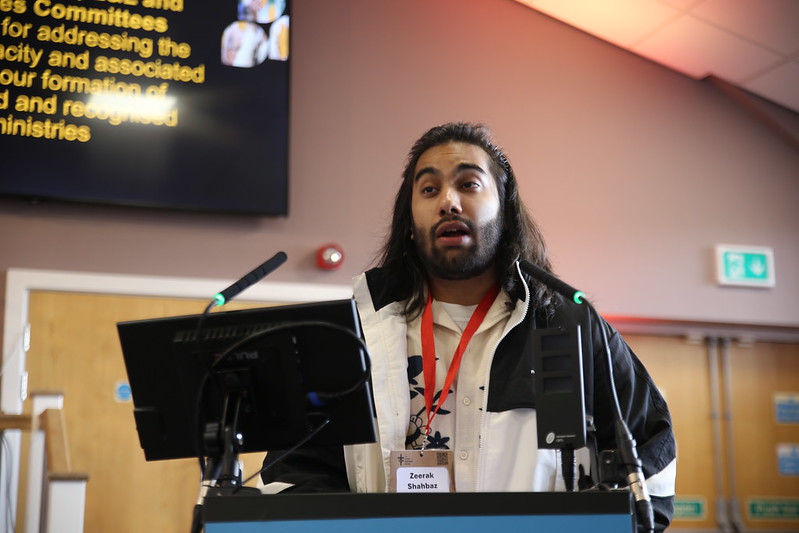
Responding to questions about ongoing college finances, Mr Yates said that “if we continue to try to support three RCLS then all of them will suffer more than they are today. A focus on two will help them support them in a more sustainable way.”
Janet Sutton, Eastern, asked if accredited ministries includes other training, and if so, would the Newbigin Hub be included. What proportion is spent outside of ministerial formation? Dr Bradbury said there is a lot of work for the wider provision of training throughout the URC, but the ecosystem of Education and Learning in the URC is complicated as it involves synods as well as RCLs.
Charlotte Remblance wondered if decisions from the Church Life Review and about pioneering posts should be made before looking at the RCLs. Responding, Dr Bradbury said all RCLs were invited to feedback to these papers, and there is no expectation that anything that happens at the November Extra General Assembly will affect this.
He also confirmed that there will be an ecumenical impact because of the decision, and Mrs Furley-Smith confirmed that the URC constantly reviews its patterns of training along with ecumenical partners. In response to a question about ongoing course outside of ministerial training, Dr Bradbury said that RCLs “are all separate entities. If we cease to use them for EM1, what happens next is primarily a decision for their governing bodies.”
Steph Atkins asked what we are trying to do to increase cohort sizes? “Are we passionately trying to encourage people to go forward to ministry?” Responding, Mrs Furley-Smith urged Assembly to challenge people you know to their call to ministry.
Moving to discussion, Tom Osborne, Methodist Church offered a welcome at Queens in Birmingham. He also said that when colleges close there can be unexpected blessings. When Wesley House stopped training Methodist ministers its work expanded globally offering Wesleyan training around the world. Church of England representative Chantal Noppen added that ecumenical training is important. She said residential training is not always best.
Dr Bradbury responded positively to a request from Sally Bateman, Northern Synod, to consider the diversity of the group examining these issues. And to the question “How do we stop the leakage?” (after students are ordained), Mrs Furley-Smith acknowledged that “one of the things that we need to look at is deployment and this is interconnected as it involves synod moderators. We may not find the perfect solution but we are aware that large pastorates are challenging.”
Maggie Kirkbride said that the church relies on lay training and wanted to be assured that it would continue and improve. Pippa Hodgson said that shouldn’t be affected, that hybrid ways are provided and that training should also meet people where they are.
At a later session, the resolutions were discussed.
Resolution 14
General Assembly determines to cease using at least one RCL for the delivery of EM1 from September 2026 for new EM1 students.
Lucy Cooke, Northern, wondered if making the decisions now ran the risk of closing doors when we should be opening them. She felt reducing the variety of places where people can train goes against new pioneering ministry and other new ways of being church. For the Equalities Committee, Jo Clare-Young asked if the remaining RCLs could be as inclusive and accessible as possible, in terms of theology, worship styles and diversity, as well as for those with accessibility and learning needs. Anne Sardeson, Eastern, reminded Assembly that it had said no to using Queens in the past, and that we should not burn bridges. Susan Durber, Wales, suggested that cohort and geographical location as well as learning styles should be factored in. She said passing this resolution could lock the task group into a path and her call was for creative, open thinking first.
Dr Bradbury replied that it had been hoped that, through engagement with the RCLs and the Education and Learning committee, it would be possible to find another way through. Many possibilities were explored, but because a path couldn’t be found, the Assembly Executive took action. The task needs to be addressed after six years of little progress, he said, and he asked that the resolution be supported.
Other concerns were raised: that some of the Church’s distinctiveness would be lost; and that a less varied programme would be offered. A former Assembly Moderator remembered that in 1973 he was part of a committee that decided to reduce five colleges down to two. He said the needs now, as then, are yet unknown. Daniel Harris, North Western Synod, added that this decision was inevitable, but emphasised that the pain needed to be recognised.
John Bradbury agreed that these decisions are tough, but we need to face the reality that lots of our local congregations have taken in the past. Regarding the diversity of what is offered, he said that both English colleges now follow the Durham Common Award, with different pathways, a pathway which was also available in Scotland through ecumenical partners. Even just one institution could offer a diverse range of learning.
Stephen Orchard, former Principal of Westminster and later a governor of Northern College, asked that we do not run away from this decision. “We can’t carry on the way we have been, but we need to look at the wider formation of ministry. Each college is an independent charity and they might be able to serve the church in other ways.”
Following an amendment that left options open, a vote on the amended resolution was carried.
Resolution 15
General Assembly adopts the financial ‘envelope’ within which funding for EM1 and RCLs must be delivered from the M&M fund.
Nigel Uden, Eastern Synod, Chair of Governors at Westminster College, asked if it was acceptable to approach other sources of funding across the URC, including the synods, for the delivery of programmes and for buildings work. However, Romilly Micklem warned that we need to carefully consider what we’re asking Synod Trust companies to do. “There is no bottomless pit of money,” he said.
The Resolution was carried.
Resolution 16
General Assembly adopts the criteria set out at 4.1 in the report as the criteria which are to be used in making determinations about which RCLs will continue to offer EM1.
Neil Thorogood, South Western Synod, a former Principal of Westminster College, reflected that there are all sorts of ways for theological education to be delivered. “Our focus is how to help Nicola [Furley-Smith] to have plenty of ministers to train and to equip others.” He said God also gives the gift and calling to be the theological educators of the future. We have been blessed by many people who have done this for us. Dr Bradbury agreed that we need the ecology to grow, but that ecology also extends beyond the colleges themselves.
Following some final clarifications, the Resolution was carried.
Resolution 17
General Assembly adopts the key aims for the future use of RCLs within the life of the United Reformed Church.
Following about clarification about the inclusion of EM1 in the thinking about colleges, this resolution was carried.
Resolutions 18 and 19
General Assembly adopted the timetable for decision-making as set out in Section 8 of the report; and invited the Revd Dr Andrea Russell to serve as an external consultant in the engagement of the working group with the RCLs.
Reporting team: Steve Tomkins, Ann-Marie Nye, Laurence Wareing and Andy Jackson. Photos: Kevin Snyman.
